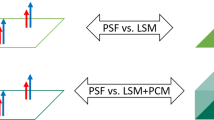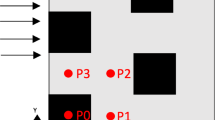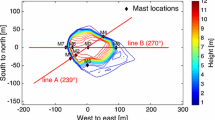Abstract
Vegetation constitutes one of the fundamental types of land use on Earth. The presence of trees in urban areas can decrease local winds and exchange sensible and latent heat with the surrounding environments, thus exerting notable influences on the urban microenvironment. A better understanding of the turbulent transfer of momentum and scalars around vegetation canopy could significantly contribute to improvement of the urban environment. This work develops a large-eddy simulation (LES) method that is applicable to model the flow and scalar transport over the forest canopy. We study the atmospheric flow over complex forested areas under typical weather conditions by coupling LES to the mesoscale model. Models of radiation and energy balance have been developed with explicit treatment of the vegetation canopy. By examining the flow over a forest canopy under a range of stability conditions, we found that buoyancy enhances or suppresses turbulent mixing in unstable or stable atmosphere respectively, with decreasing or increasing wind shear, respectively. From the multiscale modeling of the Beijing Olympic Forest Park, the present coupling scheme proves to better resolve the diurnal variations in wind speed, temperature, and relative humidity over complex urban terrains. The coupling scheme is superior to the traditional mesoscale model in terms of wind field simulation. This is mainly because the coupling scheme not only takes the influences of external mesoscale flow into consideration, but also resolves the heterogeneous urban surface at a fine scale by downscaling, thus better reproducing the complex flow and turbulent transport in the urban roughness sublayer.
Similar content being viewed by others
References
Amorim J H, Rodrigues V, Tavares R, Valente J, Borrego C. 2013. CFD modelling of the aerodynamic effect of trees on urban air pollution dispersion. Sci Total Environ, 461-462: 541–551
Arnqvist J, Segalini A, Dellwik E, Bergstrom H. 2015. Wind statistics from a forested landscape. Bound-Layer Meteorol, 156: 53–71
Arya S P. 2001. Introduction to Micrometeorology. 2nd ed. California: Academic Press. 420
Aumond P, Masson V, Lac C, Gauvreau B, Dupont S, Berengier M. 2013. Including the drag effects of canopies: Real case large-eddy simulation studies. Bound-Layer Meteorol, 146: 65–80
Bailey B N, Stoll R. 2013. Turbulence in sparse, organized vegetative canopies: A large-eddy simulation study. Bound-Layer Meteorol, 147: 369–400
Bailey B N, Stoll R, Pardyjak E R, Mahaffee W F. 2014. Effect of vegetative canopy architecture on vertical transport of massless particles. Atmos Environ, 95: 480–489
Barcons J, Avila M, Folch A. 2018. A wind field downscaling strategy based on domain segmentation and transfer functions. Wind Energy, 21: 409–425
Belcher S E, Jerram N, Hunt J C R. 2003. Adjustment of a turbulent boundary layer to a canopy of roughness elements. J Fluid Mech, 488: 369–398
Bohrer G, Katul G G, Walko R L, Avissar R. 2009. Exploring the effects of microscale structural heterogeneity of forest canopies using large-eddy simulations. Bound-Layer Meteorol, 132: 351–382
Bohrer G, Wolosin M, Brady R, Avissar R. 2007. A virtual canopy generator (V-CaGe) for modelling complex heterogeneous forest canopies at high resolution. Tellus B-Chem Phys Meteorol, 59: 566–576
Bonan G B. 2016. Ecological Climatology. 3rd ed. Cambridge: Cambridge University Press. 692
Bou-Zeid E, Parlange M B, Meneveau C. 2007. On the parameterization of surface roughness at regional scales. J Atmos Sci, 64: 216–227
Breton S P, Sumner J, Serensen J N, Hansen K S, Sarmast S, Ivanell S. 2017. A survey of modelling methods for high-fidelity wind farm simulations using large eddy simulation. Phil Trans R Soc A, 375: 20160097
Castro F A, Silva Santos C, Lopes da Costa J C. 2015. One-way mesoscale-microscale coupling for the simulation of atmospheric flows over complex terrain. Wind Energ, 18: 1251–1272
Cheng W Y Y, Steenburgh W J. 2005. Evaluation of surface sensible weather forecasts by the WRF and the eta models over the western United States. Weather Forecast, 20: 812–821
Cui G X, Zhang Z S, Xu C X, Huang W X. 2013. Research advances in large eddy simulation of urban atmospheric environment (in Chinese). Adv Mech, 43: 295–328
Dupont S, Brunet Y. 2008. Influence of foliar density profile on canopy flow: A large-eddy simulation study. Agric For Meteorol, 148: 976–990
Dwyer M J, Patton E G, Shaw R H. 1997. Turbulent kinetic energy budgets from a large-eddy simulation of airflow above and within a forest canopy. Bound-Layer Meteorol, 84: 23–43
Eder F, Serafimovich A, Foken T. 2013. Coherent structures at a forest edge: Properties, coupling and impact of secondary circulations. Bound-Layer Meteorol, 148: 285–308
Finnigan J. 2000. Turbulence in plant canopies. Annu Rev Fluid Mech, 32: 519–571
Finnigan J J, Shaw R H, Patton E G. 2009. Turbulence structure above a vegetation canopy. J Fluid Mech, 637: 387–424
Foken T. 2006. 50 years of the Monin-Obukhov similarity theory. Bound-Layer Meteorol, 119: 431–447
Gao W, Shaw R H, Paw U K T. 1989. Observation of organized structure in turbulent flow within and above a forest canopy. Bound-Layer Meteorol, 47: 349–377
Garratt J R. 1992. The Atmospheric Boundary Layer. Cambridge: Cambridge University Press. 316
Gillies J A, Nickling W G, King J. 2002. Drag coefficient and plant form response to wind speed in three plant species: Burning Bush (Euonymus alatus), Colorado Blue Spruce (Picea pungens glauca.), and Fountain Grass (Pennisetum setaceum). J Geophys Res, 107: 4760
Ji J J, Miao M Q. 1994. Numerical experiments of influence of heterogeneous vegetation distribution on the states of surface and atmospheric boundary layer (in Chinese). Sci Atmos Sin, 18: 293–302
Jiang W M, Miao S G, Zhang N, Liu H N, Hu F, Li L, Wang Y W, Wang C G. 2010. Numerical simulation on urban meteorology and urban boundary layer (in Chinese). Adv Earth Sci, 25: 463–473
Jiang W M, Miao S G. 2004. Large eddy simulation and atmospheric boundary layer-Review and prospect in the past 30 years (in Chinese). Prog Nat Sci, 14: 11–19
Jimenez P A, Dudhia J, Gonzalez-Rouco J F, Navarro J, Montavez J P, Garcia-Bustamante E. 2012. A revised scheme for the WRF surface layer formulation. Mon Weather Rev, 140: 898–918
Jimenez P A, Dudhia J. 2012. Improving the representation of resolved and unresolved topographic effects on surface wind in the WRF model. J Appl Meteorol Climatol, 51: 300–316
Jimenez P A, Dudhia J, Gonzalez-Rouco J F, Montavez J P, Garcia-Bus-tamante E, Navarro J, Vila-Guerau de Arellano J, Munoz-Roldan A. 2013. An evaluation of WRF’s ability to reproduce the surface wind over complex terrain based on typical circulation patterns. J Geophys Res-Atmos, 118: 7651–7669
Kaimal J C, Finnigan J J. 1994. Atmospheric Boundary Layer Flows: Their Structure and Measurement. New York: Oxford University Press. 289
Kruijt B, Malhi Y, Lloyd J, Norbre A D, Miranda A C, Pereira M G P, Culf A, Grace J. 2000. Turbulence statistics above and within two amazon rain forest canopies. Bound-Layer Meteorol, 94: 297–331
Lalic B, Mihailovic D T. 2004. An empirical relation describing leaf-area density inside the forest for environmental modeling. J Appl Meteorol, 43: 641–645
Launiainen S, Vesala T, MoLder M, Mammarella I, Smolander S, Rannik U, Kolari P, Hari P, Lindroth A, G. Katul G. 2007. Vertical variability and effect of stability on turbulence characteristics down to the floor of a pine forest. Tellus B-Chem Phys Meteorol, 59: 919–936
Li H F, Wang B B, Cui G X, Zhang Z S. 2015. Study on thermal environment and pollutant dispersion in real urban area by Large Eddy Simulation (in Chinese). Sci Sin-Phys Mech Astron, 45: 66–82
Li H, Cui G, Zhang Z. 2018. A new scheme for the simulation of micro-scale flow and dispersion in urban areas by coupling large-eddy simulation with mesoscale models. Bound-Layer Meteorol, 167: 145–170
Liu S H, Deng Y, Hu F, Liang F M, Liu H P, Wang J H. 2004. Numerical simulation of interaction between forest ecosystem and atmosphere boundary layer (in Chinese). Chin J Appl Ecol, 15: 2005–2012
Liu Y J, Miao S G, Hu F, Liu Y B. 2018. Large eddy simulation of flow field over the Xiaohaituo mountain division for the 24th Winter Olympic Games (in Chinese). Plateau Meteorol, 37: 1388–1401
Liu Y S, Cui G X, Wang Z S, Zhang Z S. 2011. Large eddy simulation of wind field and pollutant dispersion in downtown Macao. Atmos Environ, 45: 2849–2859
Liu Y S, Miao S G, Zhang C L, Cui G X, Zhang Z S. 2012. Study on micro-atmospheric environment by coupling large eddy simulation with mesoscale model. J Wind Eng Ind Aerodyn, 107-108: 106–117
Liu Z, Chen J M, Jin G, Qi Y. 2015. Estimating seasonal variations of leaf area index using litterfall collection and optical methods in four mixed evergreen-deciduous forests. Agric For Meteorol, 209-210: 36–48
Lorente-Plazas R, Jimenez P A, Dudhia J, Montavez J P. 2016. Evaluating and improving the impact of the atmospheric stability and orography on surface winds in the WRF model. Mon Weather Rev, 144: 2685–2693
Meneveau C, Lund T S, Cabot W H. 1996. A Lagrangian dynamic subgrid-scale model of turbulence. J Fluid Mech, 319: 353–385
Moeng C H. 1984. A large-eddy-simulation model for the study of planetary boundary-layer turbulence. J Atmos Sci, 41: 2052–2062
Moeng C H, Dudhia J, Klemp J, Sullivan P. 2007. Examining two-way grid nesting for large eddy simulation of the pbl using the WRF model. Mon Weather Rev, 135: 2295–2311
Nakai T, Sumida A, Matsumoto K, Daikoku K, Iida S, Park H, Miyahara M, Kodama Y, Kononov A V, Maximov T C, Yabuki H, Hara T, Ohta T. 2008. Aerodynamic scaling for estimating the mean height of dense canopies. Bound-Layer Meteorol, 128: 423–443
Nebenführ B, Davidson L. 2015. Large-eddy simulation study of thermally stratified canopy flow. Bound-Layer Meteorol, 156: 253–276
Nebenfiihr B, Davidson L. 2017. Prediction of wind-turbine fatigue loads in forest regions based on turbulent LES inflow fields. Wind Energ, 20: 1003–1015
Pan Y, Chamecki M, Nepf H M. 2016. Estimating the instantaneous drag-wind relationship for a horizontally homogeneous canopy. Bound-Layer Meteorol, 160: 63–82
Pan Y, Follett E, Chamecki M, Nepf H. 2014. Strong and weak, unsteady reconfiguration and its impact on turbulence structure within plant canopies. Phys Fluids, 26: 105102
Parlange M B, Brutsaert W. 1989. Regional roughness of the landes forest and surface shear stress under neutral conditions. Bound-Layer Meteorol, 48: 69–81
Pinard J D J P, Wilson J D. 2001. First- and second-order closure models for wind in a plant canopy. J Appl Meteorol, 40: 1762–1768
Poggi D, Porporato A, Ridolfi L, Albertson J D, Katul G G. 2004. The effect of vegetation density on canopy sub-layer turbulence. Bound-Layer Meteorol, 111: 565–587
Pope S B. 2000. Turbulent Flows. Cambridge: Cambridge University Press. 773
Sauer J A, Munoz-Esparza D, Canfield J M, Costigan K R, Linn R R, Kim Y J. 2016. A large-eddy simulation study of atmospheric boundary layer influence on stratified flows over terrain. J Atmos Sci, 73: 2615–2632
Schlegel F, Stiller J, Bienert A, Maas H G, Queck R, Bernhofer C. 2012. Large-eddy simulation of inhomogeneous canopy flows using high resolution terrestrial laser scanning Data. Bound-Layer Meteorol, 142: 223–243
Schlegel F, Stiller J, Bienert A, Maas H G, Queck R, Bernhofer C. 2015. Large-eddy simulation study of the effects on flow of a heterogeneous forest at sub-tree resolution. Bound-Layer Meteorol, 154: 27–56
Shaw R H, den Hartog G, Neumann H H. 1988. Influence of foliar density and thermal stability on profiles of reynolds stress and turbulence intensity in a deciduous forest. Bound-Layer Meteorol, 45: 391–409
Shaw R H, Schumann U. 1992. Large-eddy simulation of turbulent flow above and within a forest. Bound-Layer Meteorol, 61: 47–64
Shen S, Leclerc M Y. 1997. Modelling the turbulence structure in the canopy layer. Agric For Meteorol, 87: 3–25
Stoll R, Porte-agel F. 2006. Effect of roughness on surface boundary conditions for large-eddy simulation. Bound-Layer Meteorol, 118: 169–187
Su H B, Schmid H P, Vogel C S, Curtis P S. 2008. Effects of canopy morphology and thermal stability on mean flow and turbulence statistics observed inside a mixed hardwood forest. Agric For Meteorol, 148: 862–882
Tao W Q. 2004. Numerical Heat Transfer (in Chinese). 2nd ed. Xi’an: Xi’an Jiaotong University Press. 537
Tjernstrom M. 1989. Some tests with a surface energy balance scheme, including a bulk parameterisation for vegetation, in a mesoscale model. Bound-Layer Meteorol, 48: 33–68
Versteeg H K, Malalasekera W. 2007. An Introduction to Computational Fluid Dynamics: The Finite Volume Method. 2nd ed. Harlow: Pearson Prentice Hall. 517
Villani M G, Schmid H P, Su H B, Hutton J L, Vogel C S. 2003. Turbulence statistics measurements in a Northern Hardwood Forest. Bound-Layer Meteorol, 108: 343–364
Vogel S. 1989. Drag and reconfiguration of broad leaves in high winds. J Exp Bot, 40: 941–948
Wang L, Li D, Gao Z, Sun T, Guo X, Bou-Zeid E. 2014. Turbulent transport of momentum and scalars above an urban canopy. Bound-Layer Meteorol, 150: 485–511
Wyngaard J C. 2010. Turbulence in the Atmosphere. New York: Cambridge University Press. 407
Xu L, Pyles R D, Paw U K T, Chen S H, Monier E. 2014. Coupling the high-complexity land surface model ACASA to the mesoscale model WRF. Geosci Model Dev, 7: 2917–2932
Yan C, Huang W X, Miao S G, Cui G X, Zhang Z S. 2017. Large-eddy simulation of flow over a vegetation-like canopy modelled as arrays of bluff-body elements. Bound-Layer Meteorol, 165: 233–249
Yin X Y 1991. Study on turbulence in vegetation (in Chinese). Adv Mech, 25: 444–456
Yue W, Parlange M B, Meneveau C, Zhu W, van Hout R, Katz J. 2007. Large-eddy simulation of plant canopy flows using plant-scale representation. Bound-Layer Meteorol, 124: 183–203
Zhou X, Beljaars A, Wang Y, Huang B, Lin C, Chen Y, Wu H. 2017. Evaluation of WRF simulations with different selections of subgrid orographic drag over the Tibetan Plateau. J Geophys Res-Atmos, 122: 9759–9772
Acknowledgements
This work was supported by the Beijing Natural Science Foundation (Grant No. 8184074), the National Natural Science Foundation of China (Grant Nos. 41705006 & 41805011), and the Beijing Young Scholars Program.
Author information
Authors and Affiliations
Corresponding author
Rights and permissions
About this article
Cite this article
Yan, C., Miao, S., Liu, Y. et al. Multiscale modeling of the atmospheric environment over a forest canopy. Sci. China Earth Sci. 63, 875–890 (2020). https://doi.org/10.1007/s11430-019-9525-6
Received:
Revised:
Accepted:
Published:
Issue Date:
DOI: https://doi.org/10.1007/s11430-019-9525-6




